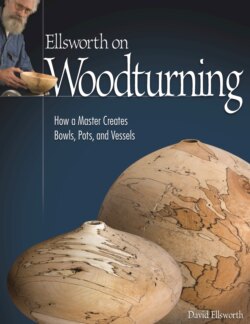Читать книгу Ellsworth on Woodturning - David Ellsworth - Страница 27
На сайте Литреса книга снята с продажи.
Parting tools
ОглавлениеParting tools are primarily used in spindle turning to define specific locations on a cylinder before the turner begins to shape the object with gouges or skews. Examples of these locations would be the left and right ends of an object, the maximum and minimum diameters of areas such as coves and beads, or any distinguishing element of the design that will help the turner understand the shape before turning it. However, I have adapted their use in making vessels when I am working in the lower quadrant near the foot of the form at the junction of the glue block, faceplate, or chuck.
One of my old standard diamond-shaped parting tools with concave surfaces above and below the tip is shown at top right.
Compare the standard diamond-shaped parting tool with the other tip designs in parting tools. The standard tip is simply too thin to maintain its edge, plus it tends to vibrate on dense dry woods.
The “barracuda”-shaped tool I use today (second from top right) has a convex surface below the tip and a concave surface above the tip. The reason for this choice was simply to introduce more mass below the cutting tip to make it more efficient and cut with less vibration.
I created this “barracuda”-shaped parting tool to make an efficient cutting tip with little vibration. This is the parting tool I use today.
The thin-bladed parting tool designed by Chris Stott (second from bottom right) has a similar feature to the barracuda-shaped tool: The slight chamfer below the tip gives it more stability during the cut.
Chris Stott designed this thin-bladed parting tool with a chamfer below the tip to give the tool stability during the cut.
And what I call “the beast” is simply an old round-nose scraper recut into a parting tool (bottom right). I made this back in the late 1970s after Ed Moulthrop explained to me that by dropping the edge below center, vibration would be greatly reduced.
"The beast" is a creation of mine from the 1970s. I re-cut an old round-nose scraper into a parting tool. Dropping the edge below center reduces vibration.
